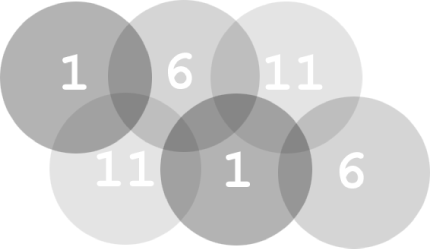|
|
|
2.4 802.11b Channels and InterferenceThe IEEE 802.11b specification details 11 possible overlapping frequencies[1] on which communications can take place. Much like the different channels on a cordless phone, changing the channel can help eliminate noise that degrades network performance and can even allow multiple networks to coexist in the same physical space without interfering with each other.
Rather than attempting to set up a single central access point with a high-gain omnidirectional antenna, you will probably find it more effective to set up several low-range, overlapping cells. If you use access point hardware, and all of the APs are connected to the same physical network segment, users can even roam seamlessly between cells. This spectrum's 11 overlapping channels are shown in Table 2-1.
The channels actually use 22MHz of signal bandwidth, so adjacent radios will need to be separated by at least five channels to see zero overlap. For example, channels 1, 6, and 11 have no overlap. Neither do 2 and 7, 3 and 8, 4 and 9, or 5 and 10. While you will ideally want to use non-overlapping channels for your access points, in a crowded setting (such as a city apartment building or office park) this is becoming less of an option. It is possible, although not ideal, to use channels that are closer together. For example, you can use channels 1 and 4 in the same space. You stand a better chance at saturating your area with usable signal from many low-power cells rather than a single tower with a high-gain antenna. As your individual cells won't need a tremendous range to cover a wide area, you can use lower gain (and lower cost) antennas, further limiting the chances of interfering with other gear in the band. As you can see in Figure 2-2, you could use as few as three channels to cover an infinitely large area, with no channel overlap whatsoever. Figure 2-2. Using non-adjacent channels, several APs can cover a large area The worst possible case would involve two separate, busy networks trying to occupy the same channel, right next to each other. The further you can get away from this nightmare of collisions, the better. Realistically, a single channel can easily support 50 or more simultaneous users, and a fair amount of channel overlap is tolerable. The radios use the air only when they actually have something to transmit, and retransmit automatically on error, so heavy congestion feels more or less like ordinary net lag to the end user. The sporadic nature of most network traffic helps to share the air and avoid collisions, like playing cards shuffling together into a pack. To sum up: be a good neighbor, and think about what you're doing before turning on your own gear. The radio spectrum is a public resource and, with a little bit of cooperation, can be used by everyone to gain greater access to network resources. |
|
|
|